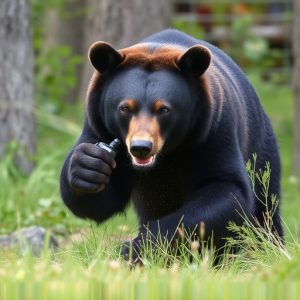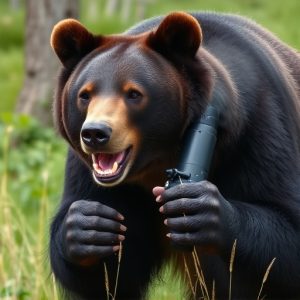Alaska Bear Spray Fog Pattern: Legal Use & Effective Application Guide
Understanding the unique fog pattern of bear spray is crucial for navigating Alaska's wildernes…….
Understanding the unique fog pattern of bear spray is crucial for navigating Alaska's wilderness safely. While effective against all bear species, its use is prohibited in specific areas like wildlife refuges and national parks due to ecological sensitivities and misidentification risks. Always check local regulations, especially in diverse ecosystems, before carrying bear spray. Effectiveness varies based on nozzle size and weather conditions. Proper application technique, understanding local rules, and using alternative deterrents alongside bear spray are essential for safety in bear country. Bear spray is legal and powerful but surrounded by myths; it can be effective against all bear species, including grizzlies in urban areas, making it relevant even in populated regions.
In Alaska, understanding bear spray fog patterns is crucial for safety during encounters with bears. This guide explores the efficacy of bear spray, delving into legal considerations and where its use is prohibited. We’ll discuss factors influencing effective fog distances, best practices for application, and debunk common myths. By following these guidelines, folks can enhance their chances of avoiding and managing potentially dangerous bear interactions in Alaska’s rugged landscape.
- Understanding Bear Spray Fog Pattern and Its Efficacy
- Legal Considerations: Where Is Bear Spray Use Prohibited?
- Factors Influencing Effective Fog Distances
- Best Practices for Applying Bear Spray in Alaska
- Common Myths Debunked: Separating Fact from Fiction
Understanding Bear Spray Fog Pattern and Its Efficacy
Understanding the bear spray fog pattern is crucial when venturing into Alaska’s wild spaces. This innovative delivery system releases a fine mist or ‘fog’ of pepper spray, designed to deter aggressive bears from approaching. Unlike direct spraying, the fog pattern creates a protective barrier, covering a wider area and reducing the risk of inhalation by the user. It’s particularly effective in close-quarters encounters, allowing individuals to back away slowly while the spray dissipates quickly, minimizing environmental impact and any harm to non-target species.
In terms of efficacy, research shows that bear spray fog can be highly successful when used correctly. However, it’s important to note that there are specific areas where bear spray use is prohibited, such as certain wildlife refuges or national parks, due to potential ecological concerns and the risk of mistaking the spray for other substances. Always check local regulations before carrying bear spray, especially in areas known for their diverse and sensitive ecosystems.
Legal Considerations: Where Is Bear Spray Use Prohibited?
In many areas, bear spray is a legal and effective tool for personal protection against bears, but there are significant legal considerations to keep in mind. While the use of bear spray is widely permitted, certain locations have strict restrictions or outright prohibit its usage. National parks, for instance, often ban the carrying of bear spray due to their focus on preserving natural behaviors and minimizing human interference in wildlife habitats. Additionally, some remote communities with frequent bear encounters may have local ordinances restricting or prohibiting bear spray use to avoid potential conflicts between residents and bears.
Understanding where bear spray use is prohibited is crucial for responsible outdoor enthusiasts and residents. It’s essential to check local, state, and national regulations before heading into bear country. Failure to comply with these restrictions can lead to severe penalties and may even put individuals at greater risk during encounters with bears. Remember that safety measures like knowledge of bear behavior, proper food storage, and making noise while traveling through bear habitats are still vital, even in places where bear spray is prohibited.
Factors Influencing Effective Fog Distances
The effectiveness of bear spray fog distance is influenced by several key factors, such as the size and type of nozzle, can design, and the atmospheric conditions. These variables determine how far the spray can reach and disperse, ensuring maximum protection during encounters with bears. For instance, larger nozzles tend to produce wider sprays that cover a broader area but may not penetrate as deeply, while smaller nozzles create tighter streams effective at longer ranges.
In addition, weather plays a significant role. Calm, humid conditions promote the best fog distribution, allowing spray to linger in the air and reach farther distances. Conversely, strong winds or dry, dusty atmospheres can reduce visibility and range of the bear spray, making it less effective when needed most. Understanding these factors is crucial for users to deploy bear spray appropriately, especially considering where bear spray is prohibited or restricted within specific regions.
Best Practices for Applying Bear Spray in Alaska
When using bear spray in Alaska, it’s crucial to understand the best practices for optimal effectiveness and safety. First, always check local regulations as some areas may have restrictions on where and when bear spray can be used. For instance, certain parks or wilderness zones might prohibit its use due to environmental concerns or specific wildlife management strategies. Knowing these rules is essential to avoid legal repercussions and protect the natural habitats.
Secondly, proper application technique is key. Aim for the face and eyes of the bear, as this is where the spray will have the most significant impact. Keep a safe distance, typically around 20-30 feet, and ensure you have a clear line of sight to the target. Spray in short bursts, allowing the can’s nozzle to remain in motion to ensure the fog pattern covers the bear effectively. Remember, bear spray is not a guaranteed solution; it’s best used as a deterrent or escape tool when combined with other safety measures like making noise and maintaining distance during encounters.
Common Myths Debunked: Separating Fact from Fiction
Many myths surround bear spray, leading to misconceptions about its effectiveness and proper usage. It’s essential to separate fact from fiction when considering this powerful tool for self-defense in bear country. One common myth is that bear spray doesn’t work on brown bears or grizzly bears because of their thick fur. However, studies show that bear spray can be highly effective against all bear species, including brown bears, when used correctly. The fog pattern creates a barrier between you and the bear, allowing the spray to reach the animal’s eyes, nose, and mouth, causing disorientation and temporary blindness.
Another debunked myth is that bear spray is only needed in remote wilderness areas. While it’s true that grizzly bears are less common in populated regions, bears can turn up anywhere, even in urban settings. In fact, many cities in bear country require residents to store bear spray within easy reach. Bear spray is not prohibited in most places but should be used responsibly and legally. Always check local regulations regarding bear spray possession and usage to ensure you’re compliant with the law and using it appropriately.
Bear spray is a valuable tool for safety in Alaska’s wild spaces, but understanding its fog pattern and effective range is key. While it can provide protection up to 30 feet, knowing legal restrictions on bear spray use in certain areas of Alaska is crucial. By following best practices, such as aiming for the face and eyes, and being mindful of myths surrounding its effectiveness, individuals can maximize their safety during encounters with bears. Remember, understanding local laws and proper usage techniques are essential to ensuring a safe outdoor experience in bear country.


